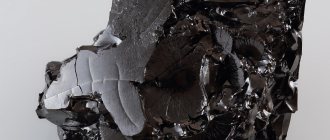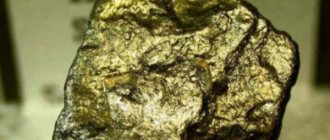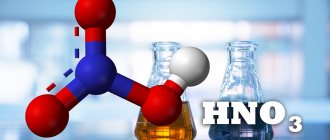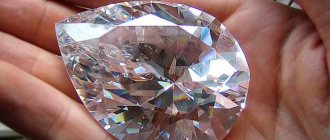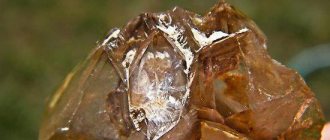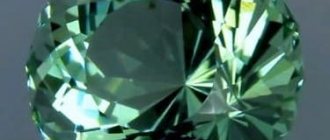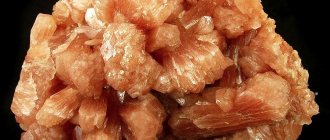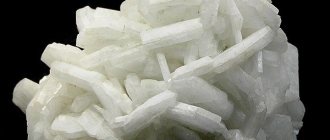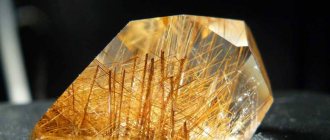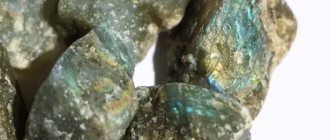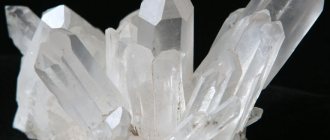The industry uses natural graphite, as well as artificial varieties of this material. Its wide range of applications is due to its unique physical and chemical properties, which may differ slightly for different brands and types of graphite.
IMPORTANT PHYSICAL AND CHEMICAL INDICATORS OF GRAPHITE:
- Thermal conductivity;
- Electrical conductivity;
- Expansion due to heat;
- Strength;
- Solubility;
- Wettability;
- Anisotropy of properties.
THERMAL CONDUCTIVITY OF GRAPHITE:
- Natural types of this material are characterized by high thermal conductivity (many metals are inferior to graphite in this indicator). It is influenced by the final processing temperature of a particular grade of graphite, but the average is 3.55 W*degrees/cm, and the thermal conductivity coefficient is 0.041. It should be noted that thin graphite filaments conduct heat better than copper counterparts.
- At a pressure of 0.9-1 atmosphere, graphite boils, reaching a temperature of 4200 degrees, and melts at 3845-3890 degrees.
- Crystalline varieties of the material ignite in an oxygen stream at 700-730 degrees Celsius.
- Combustion of graphite releases a sufficient amount of heat - up to 7856 kcal.
What is graphite
Everyone knows what graphite looks like. This is the core lead of an ordinary pencil:
- The mineral is soft, which is easy to verify: pencils break due to careless handling.
- It is greasy to the touch and has different hardness and density, as indicated by the brands of pencil - from soft to hard.
- Colors and shades - a full gray range with a matte or metallic sheen.
The layered structure of the mineral creates the ability to write or draw.
Graphite is a mineral, a natural crystalline modification of carbon. Closest relatives are diamond, lonsdaleite, charoite. They are distinguished by their structure. In graphite it is layered.
Graphite can be turned into diamond by heating it to 2000°C and placing it under pressure of hundreds of atmospheres.
In nature, “pure” minerals are not found; rare, valuable metals are found among the impurities.
The production of artificial graphite has been established.
Physical properties of graphite
One of the main properties of graphite is its ability to conduct electric current. Its physical properties differ from those of diamond in that it does not have such a high level of hardness. Its structure is initially quite soft. However, once heated, it becomes hard and brittle. The material begins to crumble.
The physical properties of graphite are as follows:
- does not dissolve in acid.
- Melting of graphite at temperatures below 3800 degrees Celsius is impossible.
- after heating it acquires a hard and brittle structure.
These are not all the properties of graphite. There are also parameters that make this element unique.
Graphite has the following characteristics:
- The melting point of graphite is 3890 degrees Celsius,
- graphite color is dark gray with a metallic sheen,
- The heat capacity of graphite is 0.720 kJ
- The resistivity of graphite is 800.000 · 10 − 8 (Ohm · Meter).
Attention:
The only parameter of all the characteristics of graphite that depends on the type of element is the thermal conductivity of graphite. It is 278.4 to 2435 W/(m*K).
Table. Physical properties of graphite.
| Characteristics | Flow direction | Temperature, °C | ||||
| 20 | 200 | 400 | 600 | 800 | ||
| Thermal conductivity coefficient λ, W/(m°C) of graphite: | ||||||
| - crystalline | || | 354,7 | 308,2 | |||
| - natural | _|_ | 195,4 | 144,2 | 112,8 | 91,9 | 75,6 |
| - pressed | || | 157 | 118,6 | 93,0 | 69,8 | 63,9 |
| - artificial with p=1.76 g/cm3 | _|_ | 104,7 | 81,4 | 69,8 | 58,2 | |
| - the same, with p = 1.55 g/cm3 | || | 130,3 | 102,3 | 79,1 | 63,9 | 53,5 |
| Tensile strength σpts, MN/m2 | || | 14,2 | 15,2 | 15,9 | 16,5 | 17,6 |
| _|_ | 10,3 | 11,3 | 12,0 | 12,5 | 13,7 | |
| Elastic modulus E, MN/m2 | || | 5880 | 7100 | 7350 | 7500 | 7840 |
| _|_ | 2700 | 3040 | 3200 | 3630 | 3920 | |
| Specific heat capacity s, kJ/(kg0C) | 0,71 | 1,17 | 1,47 | 1,68 | 1,88 | |
| Electrical resistance re104, Ohmsm | 16 | 13 | 11 | 10 | 9 | |
| Linear expansion coefficient α·106, 1/°С | || | 7,2*1 | 8,5*2 | 10,0*3 | 13,0*4 | |
| _|_ | 4,0*1 | 5,5*2 | 6,8*3 | 9,3*4 | ||
| || | 1,8*1 | 1,55*2 | 1,45*3 | 1,40*4 | ||
Story
The history and time of formation of graphite remains a mystery to science: it is too similar to other minerals in description.
The only clue is clay utensils from the Boyan Maritsa culture (the territory of modern Bulgaria and Romania, 6 thousand years ago). The products are painted with graphite paints.
Abraham Werner suggested calling the mineral graphite. This famous chemist, who “baptized” dozens of stones, took as a basis the property of the mineral to leave a clear trace of color.
The ancient Greek term γράφω means “I write.”
On the territory of Russia, graphite was found in 1826 in the Urals.
In history and literature, the mineral also appears as black/silver lead and iron carbide.
Material cost
The sale of graphite and its mixtures is carried out by special organizations that extract and receive the material. Its cost is at a quite acceptable level and depends on the carbon content and dimensions of the crystals. Each grade has its own price - the more carbon in the material, the more expensive it is and the better its technical characteristics.
Graphite is sold both wholesale and retail. It is noteworthy that when purchasing in bulk you can get a very good discount.
The cost of the material also depends on the region of sale. The average price is approximately 45-50 rubles per 1 kg. Graphite products are more expensive.
Physico-chemical characteristics
According to chemical nomenclature, the mineral graphite is pure carbon with a formula of one symbol (C).
The composition is sometimes supplemented by absorbed gas, bitumen, water, and mechanical impurities.
| Formula | C (carbon) |
| Color | Grey, black steel |
| Stroke color | Black |
| Shine | Metallic |
| Transparency | Opaque |
| Hardness | 1–2 |
| Cleavage | Perfect by {0001} |
| Density | 2.09–2.23 g/cm³ |
| singonia | Hexagonal (planaxial) |
The mineral class according to international nomenclature is native element. According to the taxonomy of the USSR, it is a non-metal, but is endowed with characteristics inherent in metals - electrical conductivity, magnetism.
Morphology
Well-formed crystals are rare. The crystals are lamellar, scaly, curved, and usually have an imperfect lamellar shape. More often it is represented by leaves without crystallographic outlines and their aggregates. Forms continuous cryptocrystalline, foliated or round radial-radiating aggregates, less often - spherulitic aggregates of a concentric-zonal structure. Coarse-crystalline precipitates often exhibit triangular shading on the (0001) planes.
Crystallographic properties
| Point group | 6 mm - dihexagonal-pyramidal |
| Space group | P63mc |
| singonia | hexagonal |
| Cell Options | a = 2.461Å, c = 6.708Å |
| Twinning | by {1121} |
Where and how is it mined?
There are commercial-scale graphite deposits on all continents:
- Both Americas - USA, Canada, Brazil;
- Europe – Germany, Greenland, Italy;
- Australia.
The raw materials of each graphite mine can be distinguished by structure, color, and other characteristics.
Russia has three largest deposits:
- Buryatia – high-quality densely crystalline raw materials.
- Krasnodar region (two) – dense, finely crystalline, scaly, graphite shales.
Graphites are formed by coal pyrolysis or under the influence of extremely high temperatures and pressure. For example, the outpouring of magma onto coal deposits.
It is mined by above-ground or underground methods. Graphite crystals are found in shales, marbles, and other organic rocks.
The annual global production of graphite is 600 thousand tons.
Place of Birth
Graphite mine
The demand for graphite in industry is very high. Today, approximate reserves around the world are estimated at 600 million tons. The largest graphite deposits are located in China, Mexico, Russia, the Czech Republic, South Korea and other countries. In addition to the countries listed, graphite is also mined on the island of Sri Lanka. Large reserves of this mineral were also found in Ukraine, in the so-called Zavalevskoe deposit. The discovered graphite deposits are industrially significant and are in great demand.
Where and how is it mined?
Graphite is mined all over the world. The ranking of countries by reserves and production in the world is presented below.
- China . About 780 thousand tons per year. In 2022, the country became the largest producer of this mineral in the world. During the year, China produced the same amount of graphite as in the previous 2 years. The US Geological Survey estimates that the country accounts for 65% of global production and 35% of consumption.
- India. 150 thousand tons were produced. Deposit reserves vary from state to state. 43% of the reserves are in Arunachal Pradesh. In total, there are 8 graphite mining and production companies in the country.
- Brazil . Production is 90 thousand tons per year. All leading manufacturing companies are private. The production level remains the same, but there are prerequisites for companies from China and India to squeeze them out of the market.
- Canada . 30 thousand tons of graphite are mined per year. Demand for Canadian graphite is growing, especially after Tesla announced it would purchase graphite for battery production from companies based in Canada.
- Mozambique . Production 23 thousand tons. Graphite mining in this country has grown from zero in 2016 to present in 2022. The pace of production is constantly increasing, the market in this region is represented by two companies.
Other countries produce less than 20 thousand tons per year. The top ten countries are rounded out by Russia (6th place), Ukraine, Pakistan, Norway and Madagascar. In total, these countries mine about 63 thousand tons of graphite per year. The graphite market in the world is constantly growing. This is due to the transition to electric batteries in many industries. The surge in electric vehicle production around the world is stimulating demand for graphite.
World consumption grew from 2013 to 2022, then there was a decrease in demand for this mineral. Prices dropped to 2017 levels as there was an oversupply and companies reduced production to stabilize world prices for the mineral.
Varieties
Natural graphite is diverse, so a classification has been developed according to several criteria.
By composition and scope of application:
- Colloidal. Technical variety, artificial graphite powder. Used by industry.
- Pyrolytic. Artificial material. Found application as the basis of tools for studying microstructures.
- Siliconized. Silicon enriched graphite. Resistant to corrosion.
Natural graphite according to its structure is divided into fibrous, densely crystalline, scaly, and graphite slate. There are also varieties - graphite and graphite mica.
Artificial graphite
Graphite is synthesized from coke and pitch. These are products of processing coal, petroleum resins, and coal tar. They are exposed chemically and mechanically at high temperatures. The raw materials are pre-sorted, then calcined and impregnated. The result is material of almost absolute purity.
Artificial graphite is used in everything from harmless plastics to nuclear equipment. The most popular brands:
- battery;
- pencil;
- casting;
- lubricating;
- electric coal;
- elemental;
- nuclear.
For each brand and area of use of graphite, the exact proportion of pitch and coke is selected.
It is not difficult to distinguish man-made samples. For example, by triangular shading on planes. Only minerals of natural origin have it.
Main brands
Today, the possibility of synthesis with different grain sizes is used. As a result, graphite can be classified into:
- coarse-grained;
- medium grain;
- fine-grained;
- fine-grained.
The elements of the first reach a diameter of 3,000 microns. If we are talking about a medium-grained variety, then the grain size is 500 microns. There is a variety of fine-grained graphite grade MPG with a grain size of up to 50 microns. There is also a fine-grained isotropic mineral of the MIG-1 brand, the particles of which have sizes from 30 to 150 microns. Fine-grained graphite and isostatic graphite have grains up to 30 microns in size, their minimum diameter is 1 micron.
Where is it used?
Graphite is almost universal. There is nothing unusual in this: the necessary characteristics are laid down at the stage of its processing. So, some require increased thermal conductivity, others require electrical conductivity. Still others are interested in the strength properties of graphite.
Taking into account the conditions of the finished product, the mineral is in demand for the following purposes:
- Production of refractory containers.
- Lubrication for smelting steel and alloys.
- Nuclear reactor rods at nuclear power plants and other units.
Souvenir graphite block - Additive to the composition of plastic products, refractories (ceramics, bricks).
- Source code for parts of electrical appliances, bearings, car springs.
- Paint used in industry and in everyday life as a protective coating against rust.
- Raw materials for the production of artificial diamonds.
- Ingredient of medicines, food paraffins, essential substances, alcohols, sugar.
The most famous use of graphite is in the core of pencils.
Moscow scientists have created a medicine from graphite to treat skin diseases.
APPLICATION
For the manufacture of melting crucibles, lining plates - the application is based on the high temperature resistance of graphite (in the absence of oxygen), on its chemical resistance to a number of molten metals. It is used in electrodes and heating elements due to its high electrical conductivity and chemical resistance to almost any aggressive aqueous solutions (much higher than that of noble metals). For the production of chemically active metals by electrolysis of molten compounds, solid lubricants, in combined liquid and paste lubricants, plastic filler.
It is a neutron moderator in nuclear reactors, a component of the composition for the manufacture of leads for black graphite pencils (mixed with kaolin). Used to produce synthetic diamonds, as a nanometer length standard for calibrating scanners of a scanning tunneling microscope and atomic force microscope, for the manufacture of contact brushes and current collectors for a variety of electrical machines, electric vehicles and overhead cranes with trolley power, powerful rheostats, as well as others devices that require reliable moving electrical contact for the manufacture of thermal protection for the nose of ballistic missile warheads and re-entry spacecraft.
Graphite – C
| Molecular weight | 12.01 g/mol |
| origin of name | from ancient Greek γράφω - to record, to write |
| IMA status | valid, first described before 1959 (before IMA) |
Therapeutic effect
Homeopaths were the first to appreciate graphite. They found that the mineral is suitable for the treatment of skin pathologies (eczema, psoriasis, lichen, etc.).
Today the list has been expanded:
- Metabolic disease.
- Malfunction of the thyroid gland.
- Respiratory tract diseases (rhinitis, bronchial asthma).
- Gastrointestinal problems (gastritis, gastric ulcer, duodenal ulcer, colitis).
- Women's ailments (amenorrhea, chronic inflammation of the ovaries, mastopathy).
- Conjunctivitis, cataracts, stye.
The mineral also “supervises” emotional health. It is prescribed for morning headaches, neurasthenia, apathy, and depression.
